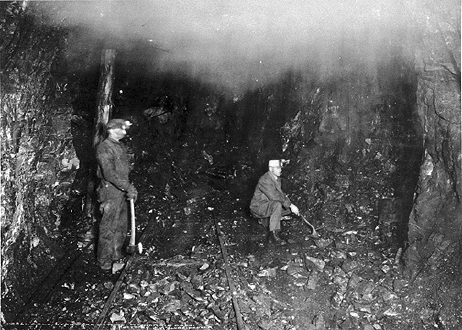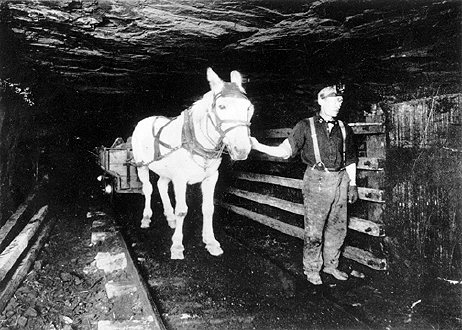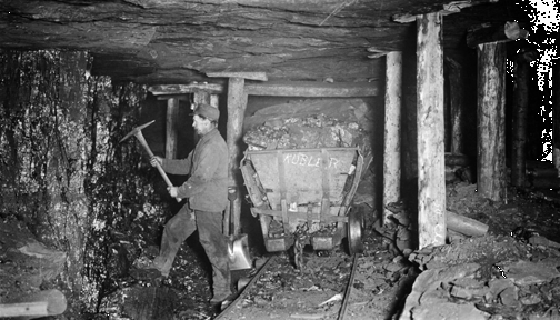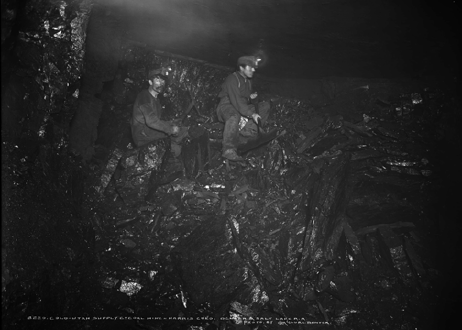Coal
What do these photos tell you about what coal mines were like?
Miners In A Coal Mine
These men are miners working inside a coalmine.

Photo: Colorado Historical Society
More About This Topic
Mining coal became an important business in Colorado during the 1880s. The smelters and steel mills needed coke made from coal. Factories and mills with machines run by steam engines used coal for fuel. As wood became more difficult to find, families began using coal to heat their houses. Colorado quickly became the largest coal mining state west of the Mississippi River.
Their Own Words
"November 19, 1886, came to Colorado, to Rockvale. Started in coal mining December 1886…. Coal was struck August 1881 at a depth of 325 feet, the bottom vein 3 feet 6 inches of coal…. The town was peopled by Scotch, Welsh and English miners. In 1886 some North Italians and Austrians came…. About 1925-26 the mine closed. Worked out."
Source: Henry Johns (1934), CWA Interview Doc. 7/366, Colorado Historical Society.
Coal Miner With A Horse
This photo was taken inside a coalmine. The miner is leading a horse that is pulling a cart filled with coal.

Photo: Colorado Historical Society
More About This Topic
The coalmines of Colorado created thousands of jobs. Many of the men who worked in the coalmines were immigrants. They came from Great Britain, Italy and other European countries.
Their Own Words
“Usually [you were paid] twice a month. . . . At the Columbine we got forty-four and a half cent a ton for loadin’ coal. If you got sixteen tons you was a good loader. . . . You had to have ideal conditions to load that [much] coal. . . . Your pay didn’t start till you started loadin’ coal. You loaded coal by the ton. You wasn’t workin’ by the hour. You was workin’ by the ton. . . . You had a snap on the end of the car. You hung your check with your number on that snap. When it went up the shaft, the weighman up there took the check off and credited it to your account.”
Source: Richard Brown quoted in Maria M. Rogers, ed., In Other Words: Oral Histories of the Colorado Frontier (Golden, CO: Fulcrum Publishing, 1996): 33.
Coal Miner In Kubler Coal Mine
The man in this photo is chipping coal from a wall with a pick. The log props behind him help keep the rock ceiling from falling down.

Photo: Denver Public Library, Western History Collection
More About This Topic
Coal mining was more dangerous work than hard-rock mining. Coal fell on miners and coal dust caused explosions. The worst mining tragedy in Colorado happened on January 24, 1884 at a coalmine at Crested Butte. Fifty-nine men were killed there in a coalmine explosion.
Their Own Words
"Tragedy struck again. Father was a loader--he shoveled coal from the chute into the railroad cars. Often coal would get hung up and he’d have to step in the chute and dig at the jammed coal to loosen it. This is what happened this day. He was picking at the coal when it broke loose before he could clear the chute; coal caved in and his foot and leg were crushed. . . . Gangrene set in the foot, and a doctor from Boulder came to Lafayette--said the foot must come off at once. Aunt Jane came, Mary came, and they shooed me out of the house. The doctor cut father’s foot and lower leg off--right there in the bedroom. The ether was so strong in the house that it nearly knocked everyone out!!"
Source: Mary Ruth Kauffman, Sarah, Her 100 Years [the Life of Sarah Savage Brillhart]. (Boulder: Gambrill Properties, Publisher, 1982): 20.
Coal Miners Near Harris
This photo was taken in a coalmine at Harris, a coal town west of Trinidad. The miners are working at a seam of coal deep underground.

Photo: Denver Public Library, Western History Collection
More About This Topic
Coal miners in Colorado tried to improve working conditions in the mines. They held meetings to protest unsafe conditions. They joined unions and went on strike for better pay and shorter hours of work. Nevertheless, mining remained a dangerous and low-paid occupation.
Their Own Words
"You remember hearing about town criers years ago! Well, we had town criers in Lafayette after the turn of the century. The miners always feared strikes, and every time they held a mass meeting they sent criers out in the streets to call the miners to the gathering. Workers were in constant insecurity about their jobs and conditions in the mines--the high accident rate, poor pay, all the poor working conditions--kept a nervous aura about the community."
Source: Mary Ruth Kauffman, Sarah, Her 100 Years [the Life of Sarah Savage Brillhart]. (Boulder: Gambrill Properties, Publisher, 1982): 21.

